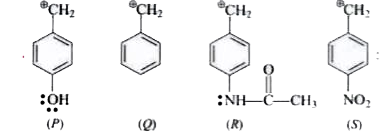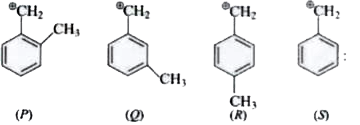The magnitude of stability constant gives an indication of the stability of ______in____ .
The correct Answer is:Complexes,solution
Step-by-Step Solution:
1. Understanding the Question: The question asks about the stability constant and what it indicates regarding stability in a specific context.
2. Identifying the Key Terms: The term "stability constant" is crucial here. It is often denoted as Kf and is associated with the stability of coordination complexes.
3. Defining Stability Constant: The stability constant (or formation constant) quantifies the stability of a complex ion formed in solution. It is derived from the equilibrium expression of the formation of a complex from its constituent ions.
4. Formation of a Complex: For example, consider the formation of a complex between cadmium ions (Cd2+) and ammonia (NH3):
Cd2++4NH3⇌(Cd(NH3)4)2+
5. Equilibrium Constant Expression: The equilibrium constant for this reaction can be expressed as:
Kf=(Cd(NH3)2+4)(Cd2+)(NH3)4
Here, Kf indicates how much the formation of the complex is favored in solution.
6. Interpreting the Magnitude of Kf: A higher value of Kf indicates a more stable complex in solution. Conversely, a lower value suggests that the complex is less stable.
7. Filling in the Blanks: Based on the understanding of the stability constant:
- The first blank should be filled with "complexes".
- The second blank should be filled with "solution".
8. Final Answer: The completed statement is:
"The magnitude of stability constant gives an indication of the stability of complexes in solution."
---
Cd2++4NH3⇌(Cd(NH3)4)2+
Kf=(Cd(NH3)2+4)(Cd2+)(NH3)4
Here, Kf indicates how much the formation of the complex is favored in solution.
- The first blank should be filled with "complexes".
- The second blank should be filled with "solution".
"The magnitude of stability constant gives an indication of the stability of complexes in solution."
Topper's Solved these Questions
- COORDINATION COMPOUNDSBOOK - CENGAGE CHEMISTRY ENGLISHCHAPTER - COORDINATION COMPOUNDSEXERCISE - Exercises True/False
14 Videos
- COORDINATION COMPOUNDSBOOK - CENGAGE CHEMISTRY ENGLISHCHAPTER - COORDINATION COMPOUNDSEXERCISE - Archives (Linked Comprehension)
5 Videos
- COORDINATION COMPOUNDSBOOK - CENGAGE CHEMISTRY ENGLISHCHAPTER - COORDINATION COMPOUNDSEXERCISE - Exercises Integer (Hybridisation , Vbt , Cft And Application)
13 Videos
- CHEMICAL KINETICSBOOK - CENGAGE CHEMISTRY ENGLISHCHAPTER - CHEMICAL KINETICSEXERCISE - Archives Subjective
23 Videos
- D AND F BLOCK ELEMENTSBOOK - CENGAGE CHEMISTRY ENGLISHCHAPTER - D AND F BLOCK ELEMENTSEXERCISE - Archives Subjective
29 Videos
Similar Questions
Knowledge Check
The correct order of stability of ions is :
 AI<IV<II<IIIBIII<II<IV<ICIV<I<II<IIIDnone of these
AI<IV<II<IIIBIII<II<IV<ICIV<I<II<IIIDnone of theseThe decreasing order of stability of following cations is
 AP>Q>R>SBQ>S>R>PCQ>P>S>RDQ>P>R>S
AP>Q>R>SBQ>S>R>PCQ>P>S>RDQ>P>R>SThe decreasing order of stability of following cations is
 AP>R>Q>SBQ>R>S>PCR>S>Q>PDP>R>S>Q
AP>R>Q>SBQ>R>S>PCR>S>Q>PDP>R>S>Q
The stability of ecosystem is maintained by
View SolutionThe reason for the stability of Gd3+ ion is
View SolutionThe decreasing order of stability of following cations is

View SolutionThe decreasing order of stability of following cations is

View SolutionThe decreasing order of stability of following cations is

View Solution
